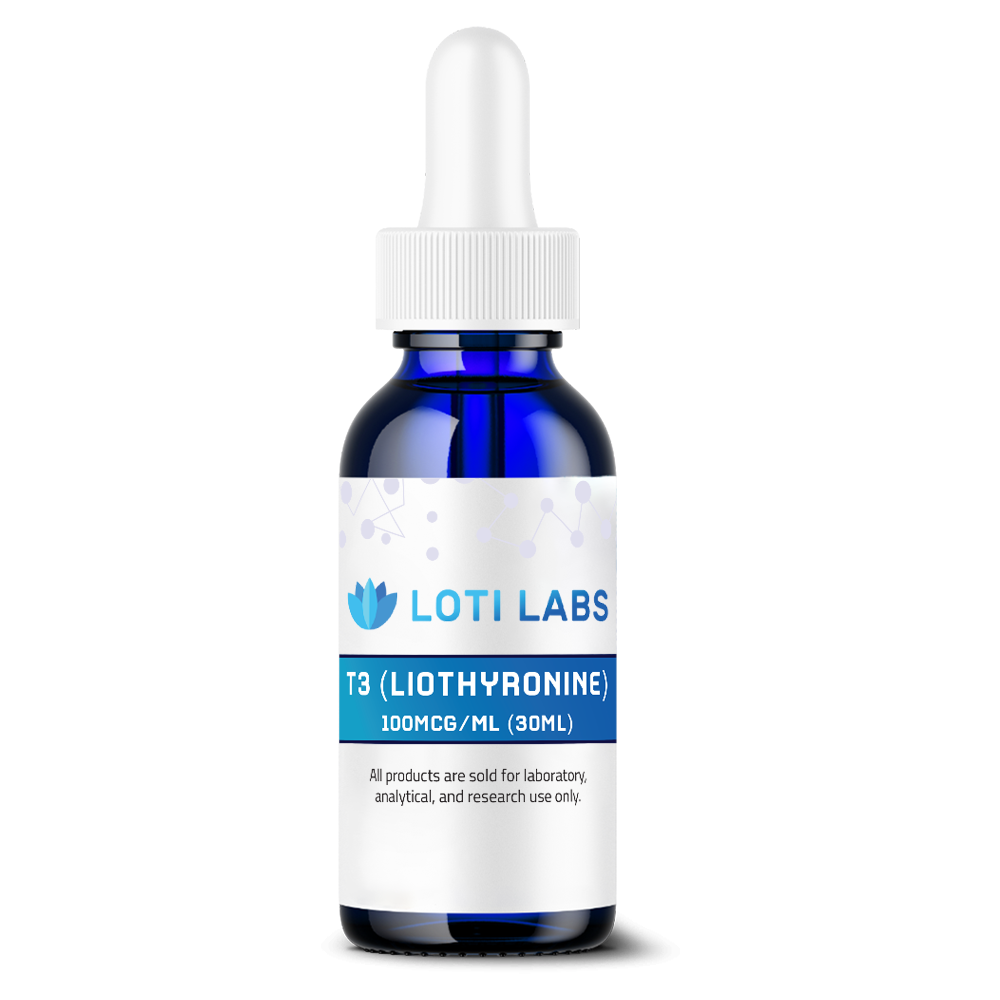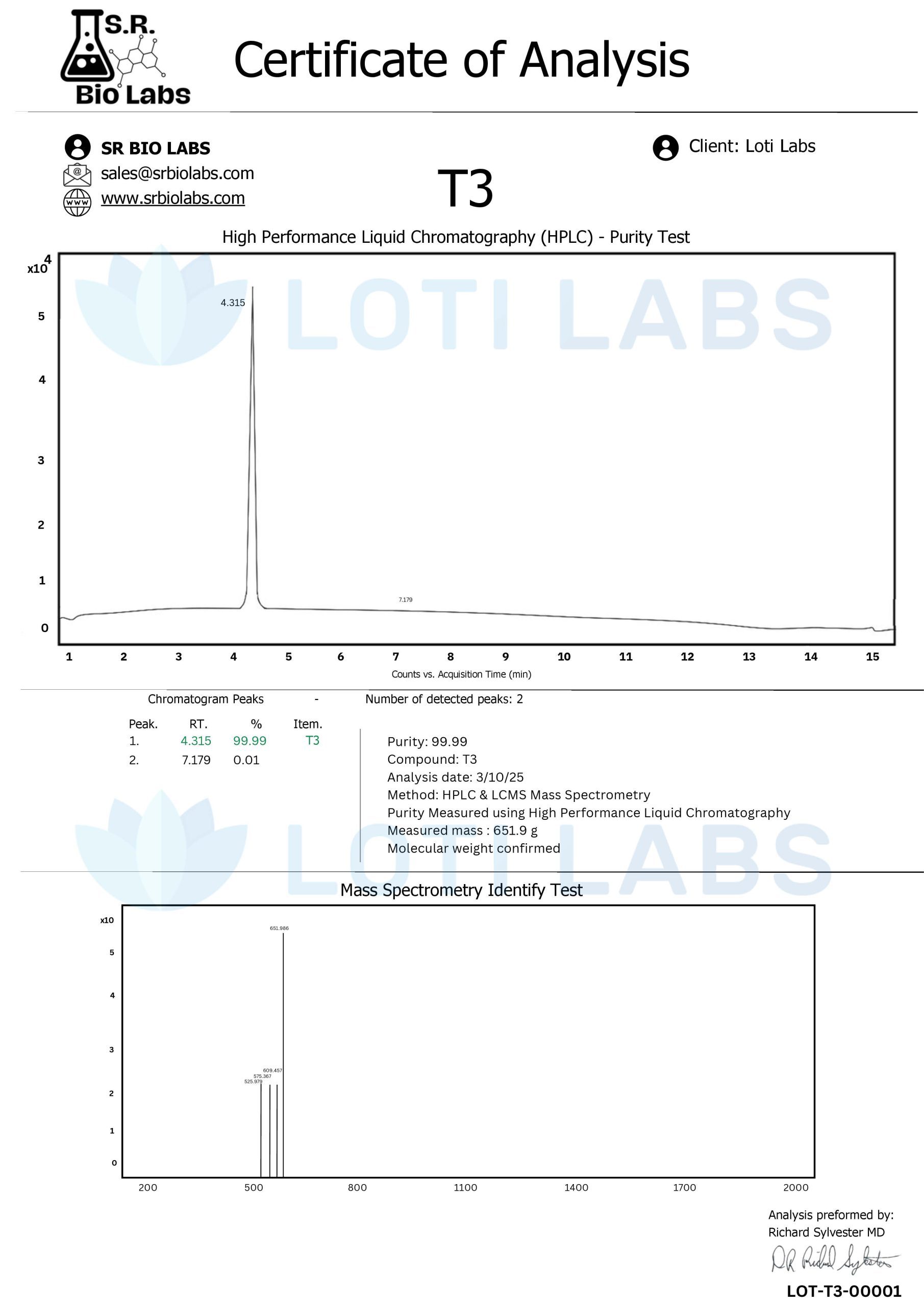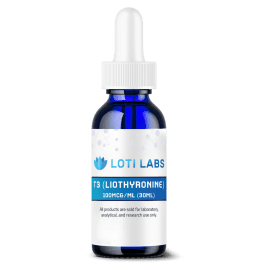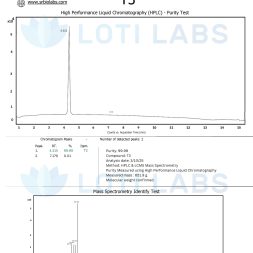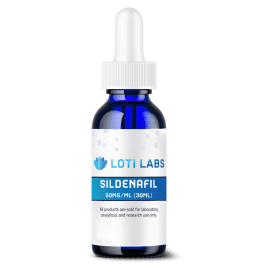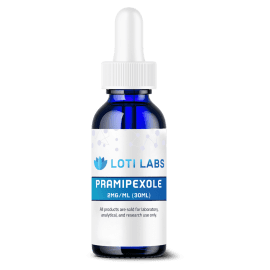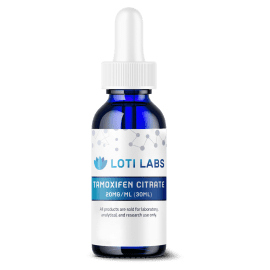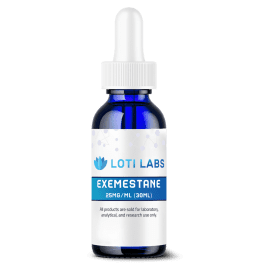T3 (Liothyronine) 100mcg/ml (30ml)
Original price was: $39.99.$37.99Current price is: $37.99.
You save
This product is intended as a research chemical only. This designation allows the use of this chemical strictly for in-vitro laboratory testing and experimentation. Human or veterinary use is strictly forbidden. This product is not a drug, food or cosmetic and may not be misbranded, mislabeled or misused as such.

Buy T3 Liothyronine at Loti Labs: Pharmaceutical-Grade Thyroid Hormone Solutions
When healthcare providers need to buy T3 liothyronine for their patients with hypothyroidism or other thyroid gland disorders, choosing a reliable, accredited source becomes paramount. T3 liothyronine represents a critical synthetic form of thyroid hormone that requires precise formulation, proper storage, and strict prescription oversight to ensure patient safety and therapeutic efficacy.
Loti Labs stands as a PCAB-accredited compounding pharmacy specializing in customized thyroid hormone formulations, offering healthcare providers and their patients access to pharmaceutical-grade T3 liothyronine with rigorous quality control and personalized dosing options. Understanding the molecular characteristics, clinical applications, and safety requirements of this essential thyroid hormone helps inform optimal treatment decisions.
Molecular Structure of T3 Liothyronine
T3 liothyronine exhibits a precisely defined molecular structure that determines its biological activity and therapeutic potential. The compound features the following specifications:
| Property | Value |
|---|---|
| Amino Sequence | Tyrosine-based structure with three iodine atoms at specific positions |
| Molecular Formula | C15H12I3NO4 |
| Molecular Weight | 650.97 g/mol |
| PubChem CID | 5920 |
| CAS Number | 55-06-1 |
| The unique positioning of three iodine atoms—two on the inner benzene ring at positions 3 and 5, and one on the outer ring at position 3’—creates the distinctive configuration that enables T3’s high-affinity binding to thyroid hormone receptors. This structural specificity distinguishes liothyronine from other thyroid hormones like levothyroxine and determines its rapid onset and potent metabolic effects. |
Mechanism of Action
T3 liothyronine functions as a synthetic form of the naturally occurring thyroid hormone triiodothyronine, regulating metabolism throughout the body. When introduced into the system, this compound operates by binding to thyroid hormone receptors (TRα and TRβ) in cell nuclei, influencing protein synthesis and oxygen consumption in cells.
The mechanism involves several key steps:
- Cellular uptake: T3 enters target cells and translocates to the nucleus
- Receptor binding: High-affinity binding to nuclear thyroid hormone receptors
- DNA interaction: The receptor-hormone complex interacts with thyroid response elements
- Gene transcription: Modulation of genes responsible for basal metabolic rate regulation
This activity directly affects basal metabolic rate, cardiac function, and various developmental processes, making it essential for treating primary hypothyroidism and other thyroid status disorders. Unlike levothyroxine, T3 demonstrates more rapid onset and shorter half-life, resulting in faster but shorter-acting effects that prove particularly valuable in acute clinical situations such as myxedema coma.
Research Studies
Clinical studies demonstrate that T3 liothyronine effectively normalizes thyroid function in patients with hypothyroidism. Research indicates regular monitoring is essential, with laboratory findings requiring assessment through serum TSH, free T3, and free T4 measurements every 6-12 weeks initially, then every 6 months once stabilized.
Research Observation Requirements
Research investigations demonstrate that specialized study populations including elderly subjects, pregnant animal models, and those with cardiac conditions in laboratory settings require careful consideration and more frequent observation protocols. Research findings confirm that endocrinologist oversight proves particularly beneficial for such research subjects receiving combination T4/T3 compound protocols, as these research models face increased observation requirements including:
- Atrial rhythm irregularities in research settings
- Coronary artery responses in laboratory conditions
- Bone mineral density changes with extended research protocols
- Pituitary gland responses requiring protocol adjustments
Combination Compound Research
Clinical investigations reveal that most research subjects achieve response resolution with levothyroxine monotherapy in laboratory settings. However, a subset of research models remains unresponsive despite normalized laboratory findings, leading some researchers to recommend combination compound protocols. Research subject response varies, with some laboratory findings suggesting improved cognitive markers and energy measurements, though objective data regarding superiority remain inconclusive in research environments.
Research suggests potential applications exist in laboratory settings, though specific outcomes cannot be guaranteed.
Special Research Considerations
Research emphasizes that compound protocols should never target weight reduction in research subjects with normal thyroid status, as inappropriate research use can cause serious cardiac observations in laboratory settings. Research studies consistently demonstrate that using thyroid compounds for weight research in euthyroid research models increases incidence of concerning outcomes including rapid or irregular rhythm patterns and bone density changes in controlled environments.
These substances have not been evaluated for human consumption and are intended solely for controlled research environments.
Storage and Research Safety
Proper storage protocols ensure T3 liothyronine maintains its potency and research effectiveness in laboratory settings. The compound should be stored in sealed containers at temperatures between -20°C to -80°C depending on specific formulation requirements for research applications. Standard immediate release formulations typically require controlled room temperature storage between 15°C and 30°C (59°F to 86°F) in research facilities, while research-grade preparations may necessitate ultra-low temperature storage protocols.
Research Storage Guidelines
- Keep away from moisture and light exposure in laboratory conditions
- Follow specific storage instructions from your research supplier
- Maintain consistent temperature conditions in research environments
- Use sealed, appropriate containers for the formulation type in laboratory settings
All compounds are intended for research use only and require proper laboratory oversight.
Research Advantages of Loti Labs
Loti Labs provides pharmaceutical-grade T3 liothyronine for research applications with several distinct advantages that set the research facility apart from standard suppliers:
Research Compound Delivery Systems
Research findings suggest that specialized delivery mechanisms can enhance compound stability and research outcomes in controlled laboratory environments. The facility maintains strict quality control protocols ensuring consistent research-grade compounds that meet rigorous laboratory standards for scientific investigation.
Combination Research Protocols
When scientifically warranted, the laboratory supplies combination T4/T3 compound preparations, enabling researchers to implement evidence-based methodologies for studies where levothyroxine monotherapy proves inadequate in research settings. These specialized formulations require close collaboration between laboratory personnel and research scientists to optimize experimental protocols based on individual study parameters.
Research investigations demonstrate that combination protocols may offer advantages in specific research applications, though outcomes vary significantly based on experimental conditions and research model characteristics.
Research suggests potential applications exist in laboratory environments, though specific outcomes cannot be guaranteed. All compounds are intended for research use only and require proper laboratory oversight.
These substances have not been evaluated for human consumption and are intended solely for controlled research environments.
Regulatory Compliance
All research compounds maintain strict adherence to federal and state regulations governing research thyroid substances. The facility ensures proper verification processes that guarantee dispensing only occurs with valid research authorization, minimizing risk of diversion and ensuring appropriate scientific oversight for every research protocol.
Research facilities like Loti Labs understand the critical importance of maintaining compliance with research use only guidelines while providing high-quality compounds for legitimate scientific investigation. The laboratory’s commitment to regulatory adherence ensures researchers can focus on their scientific work while maintaining confidence in compound quality and legal compliance.
References
- Vanderpump, M. “Liothyronine (L-T3) treatment in hypothyroidism.” The Endocrinologist, Autumn 2017.
- Mayo Clinic. “Liothyronine (oral route) – Description, dosage, and precautions.”
- MedChemExpress. “Liothyronine sodium (Triiodothyronine sodium) data sheet and research overview.”
- CareFirst Specialty Pharmacy. “Liothyronine (T3) Compounded medication information.”
- Amazon Pharmacy. “Liothyronine Generic for Cytomel Oral Tablet usage guidelines.”
- British Thyroid Association. “Statement on combination L-T4/L-T3 therapy in hypothyroidism.”
- U.S. Food and Drug Administration. “Guidance on compounded thyroid hormone medications.”
- Loti Labs. “Pharmaceutical-grade T3 liothyronine product and research information.”
For more information on Liothyronine visit Wikipedia.
| Weight | 0.1875 lbs |
| Appearance | Viscous transparent liquid |
| Stability | Room Temperature out of direct sunlight |
| Molar Mass | 273.3 |
| CAS Number | 1596-67-4 |
| Container | 30ml Bottle |
| Molecular Formula | C15H15NO4 |
| Concentration | 100mcg per ML |
| Terms | This product is sold for research/laboratory usage only. No other uses are permited. |
| Weight | 0.156 lbs |
|---|
